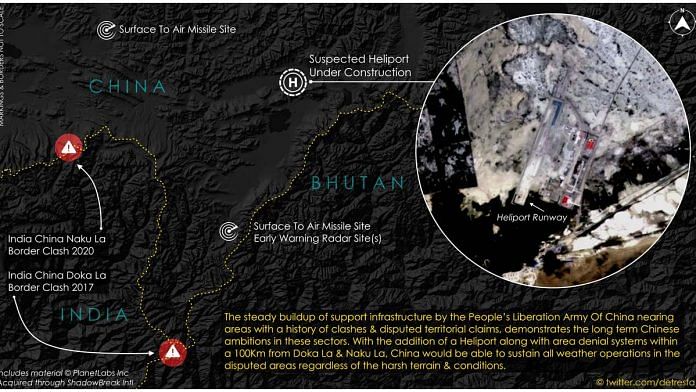New Delhi: In the midst of its massive military build-up along the Line of Actual Control, China is building heliports close to its borders with India, ThePrint has learnt.
This includes one heliport near Doklam, which lies on the tri-junction of India, China and Bhutan — the site of the 73-day stand-off that took place between the two Asian powers in 2017.
The development comes to light at a time when satellite images have surfaced showing China also building a new surface-to-air missile location to cover a critical gap in its air defence.
This also comes amid reports of a fresh clash between the Indian and Chinese troops on the intervening night of 29 August and 30 August on the southern bank of Pangong Tso in eastern Ladakh.
ThePrint and anonymous open source satellite imagery expert @detresfa_ worked together to take a detailed look at the heliport development in Doklam.
Also read: Fresh clash in Ladakh, Indian Army ‘thwarts’ China move to change status quo at Pangong Tso
Heliports under construction in eastern Ladakh too
According to information by @detresfa_, the Chinese are also constructing two new heliports in eastern Ladakh — one in Tianshuihai, which is near the Galwan Valley and the Aksai Chin region, and the other in Rutog County, which is near the northern bank of Pangong Tso.
As reported by ThePrint earlier, China has also continued construction activities on its side of the LAC in the western sector, even though it is involved in talks with India to de-escalate.
There has been no movement in disengagement talks since July.
According to sources in the security and defence establishment, the construction is meant to provide back-up for the thousands of troops China has moved forward near Ladakh, and also into the Indian side, and may also be a possible pressure tactic.
China’s withdrawal in July from near the Y Junction in the Galwan Valley, which is on the Indian side, is seen more as a fallout of the Galwan river’s rising water level making its troops’ stay untenable, rather than any sincere effort to disengage, sources had told ThePrint earlier.
China’s larger strategy
Sim Tack, an analyst with the geopolitical intelligence platform Stratfor, who works closely with @detresfa_, said: “What the new imagery shows is the likely construction of a base that will support regional helicopter operations. It is very similar in size and layout to some other facilities that China has built in recent years, including several in and around the disputed Ladakh territory.”
Tack added that the heliport appears to be part of a broader Chinese effort to upgrade and expand military facilities along the Tibetan plateau.
“These have also included new airbases, or expansions of airbases, and many new air defence positions,” said Tack, who has been closely studying the developments along the LAC.
He added that all these different expansions fit into a larger strategy, similar to the Chinese infrastructure development in the South China Sea.
“It suggests that Beijing plans to more aggressively pursue its territorial claims along its western border,” he said.
@detresfa_ added that the steady build-up of support infrastructure by the People’s Liberation Army (PLA), in areas which have a history of clashes and disputed territorial claims, demonstrates the long-term Chinese ambitions.
“With the addition of a heliport along with the aerial denial systems within 100 km from Doka La and Naku La, China would be able to sustain all weather operations in the disputed areas regardless of the harsh terrain and conditions,” he said.
Also read: India withdraws from Russia military exercise, participation of China & Pakistan a factor







TS Darbari – India needs to build strong military facilities along the LAC which have long been denied. Though the government has taken numerous steps to fortify national security not only along the border but within India too. Urban Naxalism, on the behest of China, is a great threat to Indian security. We saw the results of urban naxalism in Delhi when the educated people and the ruling party in Delhi led the riots and mass-murdered numerous people to please a particular community and section of society. Still, their supporting media did not raise even a single question on the ruling party. It shows how urban Naxalism has entered media houses and is working as per the directions given to it by its masters. Therefore, India needs to work on making media more responsible through rules and regulations. For example- The duty of media houses is to just report an incident and not to try to create an opinion. Therefore, an incident should be explained the way it took place not the opinion of media should be included in it. If the media does not follow the guideline, it must be punished by law. Secondly, media houses must work as an NPO, not as a profit-earning business house so that it can not be corrupted. Thirdly, only volunteers should be part of media, not full-time employees.
#TSDarbari T S Darbari #TS_Darbari #TSDarbariBlog #TSDarbariBlogger #TSDarbarithoughts
China will soon take all ladkh a. Are from India and India see it soon
When will Modi speak??
PLA is telling Modi Fight or Flee !!!